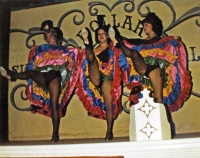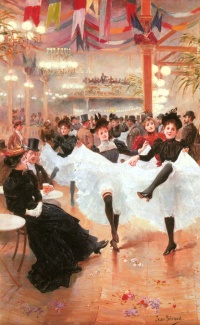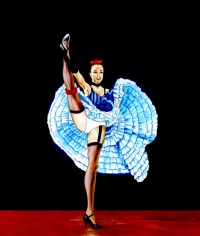Can-can
(New article) |
Midnight68 (Talk | contribs) m (→See also) |
||
| (9 intermediate revisions by 2 users not shown) | |||
| Line 1: | Line 1: | ||
| − | + | [[Image:5208769119 d63ea98e72 o.jpg|thumb|right|200px|<center><small>Can-can dancers.</small></center>]] | |
| + | The '''cancan''', sometimes hyphenated as '''can-can''', was the forerunner to modern [[burlesque]] and [[striptease]]. In the present day, it is a high-energy [[Wikipedia:Music hall|music hall]] dance, traditionally performed by a [[Wikipedia:Chorus line|chorus line]] of female dancers who wear costumes with long skirts, [[petticoat]]s, and black stockings. The main features of the dance are the lifting and manipulation of the skirts, with [[Wikipedia:Glossary of ballet terms#Battement|high kick]]ing and suggestive, provocative body movements, allowing the audience to see their [[panties|knickers]], [[stockings]] and [[suspenders]]. | ||
| − | + | The ''Infernal Galop'' from [[Wikipedia:Jacques Offenbach|Jacques Offenbach]]'s ''[[Wikipedia:Orpheus in the Underworld|Orpheus in the Underworld]]'' is the tune most associated with the can-can, although a wide variety of musical pieces have been written for both the stage and the cinema, many of them based on Offenbach's composition. While the cancan is now considered a part of world dance culture, it still retains something of a risque connotation for many. | |
| + | |||
| + | ==Origins== | ||
| + | [[File:Jean Béraud Le Cafe de Paris.jpg|thumb|200px|<center><small>Artwork by Jean Béraud.</small></center>]] The cancan first appeared in the working-class ballrooms of [[Wikipedia:Montparnesse|Montparnasse]] in [[Wikipedia:Paris|Paris]] around 1830. It was a more lively version of the [[Wikipedia:Gallop|galop]], a dance in quick [[Wikipedia:time signature|2/4 time]], which often featured as the final figure in the [[Wikipedia:Quadrille|quadrille]]. The cancan was, therefore, originally a dance for couples, who indulged in high kicks and other gestures with arms and legs. It is thought that they were influenced by the antics of a popular entertainer of the 1820s, Charles Mazurier, who was well known for his acrobatic performances, which included the [[Wikipedia:grand écart|grand écart]] or [[Wikipedia:Jump splits|jump split]]s — later a popular feature of the cancan. At this time, and throughout most of the 19th century in France, the dance was also known as the ''chahut.'' Both words are French, ''cancan'' meaning "tittle-tattle" or "scandal," hence a scandalous dance, while ''chahut'' meant "noise" or "uproar." The dance caused something of a scandal, and for a while, there were attempts to repress it. Occasionally people dancing the cancan were arrested but it was never officially banned, as is sometimes claimed. | ||
| + | |||
| + | As performers of the cancan became more skilled and adventurous, it gradually developed a parallel existence as entertainment, alongside the participatory form, although it was still very much a dance for individuals and not yet performed on stage by a chorus line. A number of female performers achieved widespread notoriety during this period. They were mostly middle-ranking courtesans, and only semiprofessional entertainers—unlike the dancers of the 1890s, such as [[Wikipedia:La Goulue|La Goulue]] and [[Wikipedia:Jane Avril|Jane Avril]], who were highly paid for their appearances at the [[Wikipedia:Moulin Rouge|Moulin Rouge]] and elsewhere. The female dancers of the Second Empire and the [[Wikipedia:fin de siècle|fin de siècle]] developed the various cancan moves that were later incorporated by the choreographer [[Wikipedia:Pierre Sandrini|Sandrini]] in the spectacular "French Cancan", which he devised at the Moulin Rouge in the 1920s and presented at his own [[Wikipedia:Bal Tabarin (Paris)|Bal Tabarin]] from 1928. This was a combination of the individual style of the Parisian dance-halls and the chorus-line style of British and American music halls. | ||
| + | |||
| + | ==Performance== | ||
| + | [[File:PatEnLair.jpg|thumb|200px|<center><small>''Port d'armes.''</small></center>]] In the [[Wikipedia:United Kingdom|United Kingdom]], the [[Wikipedia:United States|United States]] and elsewhere, the cancan achieved popularity in music halls, where it was danced by groups of women in tightly choreographed routines. | ||
| + | |||
| + | Humor and acrobatics played a significant role at this stage of development. In some instances, the dancer would stand close by a patron, betting she could remove his hat without using her hands. Upon taking the bet, the girl would execute a high kick that would take off his hat, simultaneously revealing her underwear to the audience. | ||
| + | |||
| + | This style was imported back to France in the 1920s for the benefit of tourists, and the '''French Cancan''' was born — a highly choreographed routine lasting ten minutes or more, with the opportunity for individuals to display their specialities. The main moves are the [[Wikipedia:Glossary_of_ballet#Battement|high kick]] or [[Wikipedia:Glossary of ballet#Battement|battement]], the ''[[Wikipedia:Glossary of ballet#Rond de jambe|rond de jambe]]'' (quick rotary movement of lower leg with knee raised and skirt held up), the ''port d'armes'' (turning on one leg, while grasping the other leg by the ankle and holding it almost vertical), the [[wikipedia:cartwheel (gymnastics)|cartwheel]] and the grand écart (the flying or jump splits). It has become common practice for dancers to scream and yelp while performing the cancan, but this is by no means essential. | ||
| + | |||
| + | Throughout the Twentieth Century, the cancan was a popular mainstay in all-male reviews, frequently performed by female impersonators for mixed audiences. | ||
==See also== | ==See also== | ||
* [[Choreophilia]] | * [[Choreophilia]] | ||
* [[Dance]] | * [[Dance]] | ||
| + | * [[Upskirt]] | ||
| + | [[Category:Cancan]] | ||
| + | [[Category:Dancing]] | ||
| + | [[Category:Exhibitionism]] | ||
| + | [[Category:Fetish]] | ||
| + | [[Category:Stockings]] | ||
| + | [[Category:Suspenders]] | ||
[[Category:Other Topics]] | [[Category:Other Topics]] | ||
| + | [[Category:Panties]] | ||
| + | [[Category:Voyeurism]] | ||
Latest revision as of 06:18, 22 November 2023
The cancan, sometimes hyphenated as can-can, was the forerunner to modern burlesque and striptease. In the present day, it is a high-energy music hall dance, traditionally performed by a chorus line of female dancers who wear costumes with long skirts, petticoats, and black stockings. The main features of the dance are the lifting and manipulation of the skirts, with high kicking and suggestive, provocative body movements, allowing the audience to see their knickers, stockings and suspenders.
The Infernal Galop from Jacques Offenbach's Orpheus in the Underworld is the tune most associated with the can-can, although a wide variety of musical pieces have been written for both the stage and the cinema, many of them based on Offenbach's composition. While the cancan is now considered a part of world dance culture, it still retains something of a risque connotation for many.
[edit] Origins
The cancan first appeared in the working-class ballrooms of Montparnasse in Paris around 1830. It was a more lively version of the galop, a dance in quick 2/4 time, which often featured as the final figure in the quadrille. The cancan was, therefore, originally a dance for couples, who indulged in high kicks and other gestures with arms and legs. It is thought that they were influenced by the antics of a popular entertainer of the 1820s, Charles Mazurier, who was well known for his acrobatic performances, which included the grand écart or jump splits — later a popular feature of the cancan. At this time, and throughout most of the 19th century in France, the dance was also known as the chahut. Both words are French, cancan meaning "tittle-tattle" or "scandal," hence a scandalous dance, while chahut meant "noise" or "uproar." The dance caused something of a scandal, and for a while, there were attempts to repress it. Occasionally people dancing the cancan were arrested but it was never officially banned, as is sometimes claimed.As performers of the cancan became more skilled and adventurous, it gradually developed a parallel existence as entertainment, alongside the participatory form, although it was still very much a dance for individuals and not yet performed on stage by a chorus line. A number of female performers achieved widespread notoriety during this period. They were mostly middle-ranking courtesans, and only semiprofessional entertainers—unlike the dancers of the 1890s, such as La Goulue and Jane Avril, who were highly paid for their appearances at the Moulin Rouge and elsewhere. The female dancers of the Second Empire and the fin de siècle developed the various cancan moves that were later incorporated by the choreographer Sandrini in the spectacular "French Cancan", which he devised at the Moulin Rouge in the 1920s and presented at his own Bal Tabarin from 1928. This was a combination of the individual style of the Parisian dance-halls and the chorus-line style of British and American music halls.
[edit] Performance
In the United Kingdom, the United States and elsewhere, the cancan achieved popularity in music halls, where it was danced by groups of women in tightly choreographed routines.Humor and acrobatics played a significant role at this stage of development. In some instances, the dancer would stand close by a patron, betting she could remove his hat without using her hands. Upon taking the bet, the girl would execute a high kick that would take off his hat, simultaneously revealing her underwear to the audience.
This style was imported back to France in the 1920s for the benefit of tourists, and the French Cancan was born — a highly choreographed routine lasting ten minutes or more, with the opportunity for individuals to display their specialities. The main moves are the high kick or battement, the rond de jambe (quick rotary movement of lower leg with knee raised and skirt held up), the port d'armes (turning on one leg, while grasping the other leg by the ankle and holding it almost vertical), the cartwheel and the grand écart (the flying or jump splits). It has become common practice for dancers to scream and yelp while performing the cancan, but this is by no means essential.
Throughout the Twentieth Century, the cancan was a popular mainstay in all-male reviews, frequently performed by female impersonators for mixed audiences.


